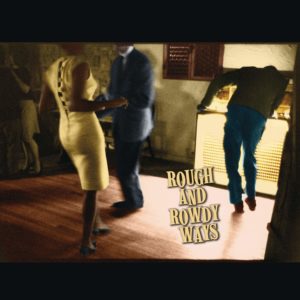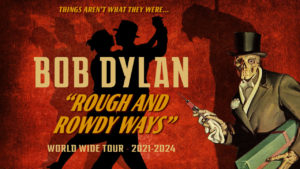No frills. No small talk. Almost no acknowledgement of his audience. Monday April 1, at the Saenger Theatre in New Orleans, Bob Dylan stayed focused on music and the sly poetry that fills his songs.
In a nearly two-hour show, the outwardly undemonstrative Dylan and his five-man band performed seventeen songs, many of them from his 2020 album, Rough and Rowdy Ways. He borrowed the album’s title from Jimmie Rodgers’ “My Rough and Rowdy Ways.” The latter song’s lyrics tell of man who settles down with the perfect lady but then can’t renounce his rambling and drinking.
At 82, Dylan rambles, too, albeit in a tour bus rather than a boxcar. The worldwide Rough and Rowdy Ways tour, launched in 2021, is rolling to this day, including Monday’s show in New Orleans and a performance in nearby Lafayette the following day. This summer Dylan will hitch his wagon to the 2024 Outlaw Music Festival Tour, featuring his fellow traveler, Willie Nelson.
Rough and Rowdy Ways is his first album since he won the Nobel Prize for Literature in 2016. The Swedish Academy placed singer-songwriter Dylan in the company of T.S. Eliot, Samuel Beckett, Toni Morrison and Gabriel García Márquez. The academy’s permanent secretary, literary scholar Sara Danius, explained its reasons for doing so, citing Dylan as “a great poet in the English-speaking tradition” who has constantly reinvented himself. And like the works of classic Greek poets Homer and Sappho, Danius said, Dylan’s poetry is “meant to be listened to, meant to be performed, often together with instruments.”
Poetry performed with musical accompaniment is exactly what Dylan did Monday night at the Saenger Theatre. He doesn’t so much sing as recite his lyrics, doing so stylistically in his distinctive cadences and unmistakable voice. Even though few familiar songs made the night’s set list—and those that did were musically recast—Dylan delivered one hundred percent of himself and his art.
Starting the concert at precisely 8 p.m., Dylan’s band played without him for five minutes, until the star ambled out to the piano positioned at stage center. In the Saenger, the jewel of Canal Street in walking distance of the Mississippi River, Dylan and his band opened with a good-natured, more country than blues-rock take on one of his classics, “Watching the River Flow.”
The amiable country groove continued with “Most Likely You Go Your Way and I’ll Go Mine.” Another blast from Dylan’s storied past, the song first appeared on his 1966 album, Blonde on Blonde. Recent work followed, starting with Rough and Rowdy Ways’ opening song, “I Contain Multitudes.” Like the Swedish Academy said, the song’s lyrics are worth hearing and reading. “I Contain Multitudes” drops names like the cover of Sgt. Pepper’s Lonely Hearts Band. Its rhyming lyrics pop with scathing lovers’ pleas and threats. “I’m just like Anne Frank, like Indiana Jones, and them British bad boys, the Rolling Stones,” Dylan states. “I go right to the edge, I go right to the end. I go right where all things lost are made good again.”
Dylan’s clever lyrics were sometimes decipherable during his Saenger performance, sometimes not. Because his words are so worth hearing and knowing maybe subtitles are in order. On the other hand, familiarizing oneself with the lyrics before attending a Dylan concert may be the way to go. That’s doable because his set lists reportedly don’t change much.
A lover of American roots music, Dylan demonstrated his affection for blues with “False Prophet.” He matched the song’s slow blues swagger with bold lyrics that are both personal and political. “Well, I’m the enemy of treason, enemy of strife,” he proclaimed. “Enemy of the unlived meaningless life. I ain’t no false prophet. I just know what I know. I go where only the lonely can go.”

For “False Prophet,” and every other song he performed, Dylan played piano, the instrument of choice in these vibrant twilight years. He sat at the keyboard as well as periodically rose to crouch over it. Meanwhile, the acoustic guitar he became famous for in the early 1960s and the electrics he played from the mid-’60s forward were verboten.
Moving to the past again, another Dylan classic, “When I Paint My Masterpiece,” received a wry re-creation. Its principal riff sounded suspiciously like the melody in “Putting on the Ritz,” a 1920s pop classic by Dylan’s fellow great American Jewish composer, Irving Berlin. At this deeper point in the show, another of the concert’s interpretations, Hank Williams’ “On the Banks of the Old Pontchartrain,” was a perfect choice for Dylan and his audience in New Orleans.
Dylan’s penchant for reciting lyrics was especially evident in Rough and Rowdy Ways’ “Crossing the Rubicon.” His lyrics for the hypnotic blues dirge-boogie veered between darkness and light. He testified in beat-poet rhythm and threw a burst of piano trills into the feverish mix. Dylan later cited the beats as well as some musical heroes in the playfully dark “Key West (Philosopher Pirate).” “I was born on the wrong side of the railroad track,” Dylan’s lyrics claim. “Like Ginsberg, Corso and Kerouac. Like Louis and Jimmy and Buddy and all the rest.” Amidst its rich ruminations, the song’s tropical musical backdrop could be a variation on Ben E. King’s pop classis, “Stand By Me.”
Dylan and his music and poetry do indeed stand with the beat poets and jazz and blues kingpins he mentions in “Key West.” No brag, just fact. As his 83rd birthday on May 24th approaches, Dylan’s engaging performance at the Saenger and ongoing creativity provide more evidence of that.



